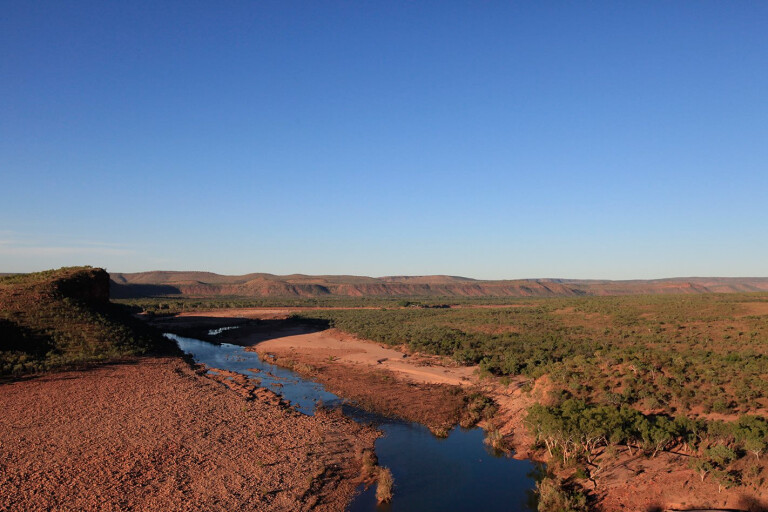
We knew the swim would be brief. The sun was sinking behind the gorge walls, and we didn’t have head torches to negotiate the hike back to our vehicles. Still, we shivered happily in the deep blue waterhole, surrounded by cathedral-like ancient rock.
This article was originally published in the October 2011 issue of 4x4 Australia.
Necks craned, we were watching ornithologist (bird expert) Simon Cherriman abseil down the face of Amalia Gorge, in El Questro Wilderness Park, in the northern Kimberley. Simon was using his climbing skills – handy for birdwatching – to conduct a vertical transect of the gorge wall, tagging cracks and crevices for future studies on behalf of the herpetologists (amphibian and reptile biologists) monitoring his descent from below. Most of the scientists would stay until dark and return later that evening in search of Litoria splendida, the brightly-coloured (and aptly-named) magnificent tree frog, found only in the Kimberley.
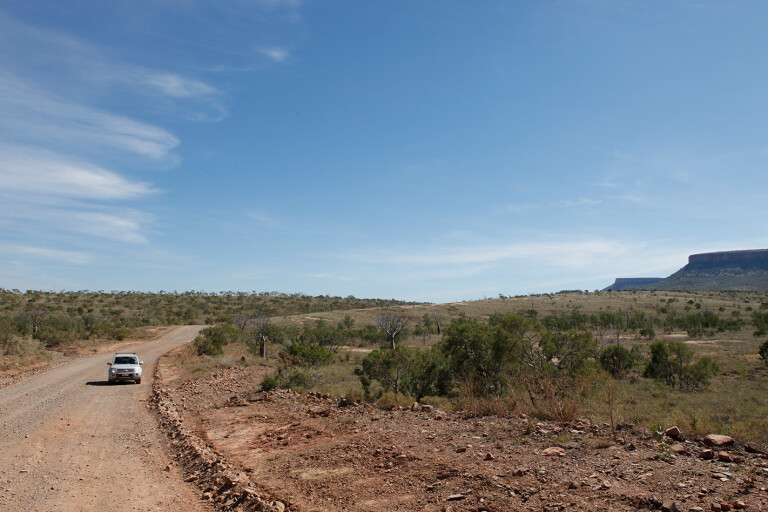
Scattered around the rest of the park – and as far as the lower Ord River, near Kununurra – scientists and volunteers were partaking in their own studies, from goannas, fish and freshwater crocodiles, to turtles and small native mammals, each with a common cause, to document species and habitats before the onslaught of the feral cane toad in this pristine wilderness. A sad and, it seems, inevitable reality. The expedition, funded and organised by the Australian Geographic Society (AGS), would constitute one of the country’s first ‘before and after’ studies of an area affected by the cane toad, providing a more accurate picture of the pest’s true impact.
Back at Amalia Gorge, the rest of us, including rock-star herpetologist Steve Wilson – whose accomplishments lent him near-celebrity status among the younger biologists – dried ourselves and commenced the rocky walk back to our waiting 4X4s.
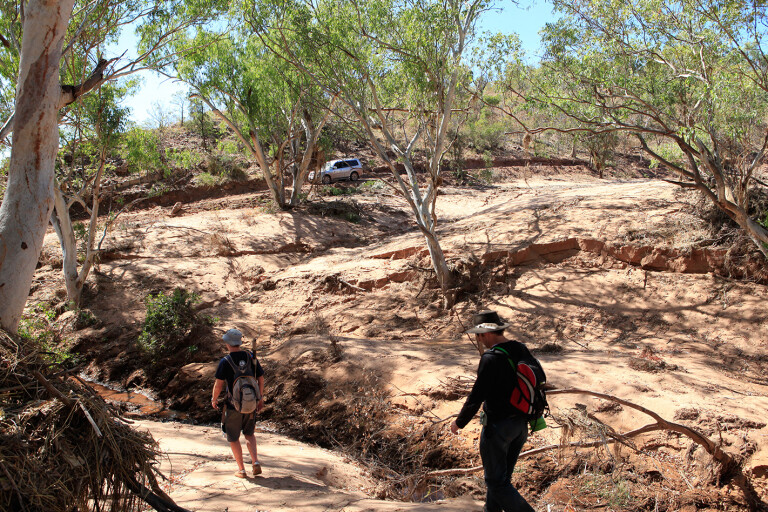
I had learnt to look closer at the rock beneath my feet at this time of day, cautious of snakes enjoying the lingering warmth before the onset of the cool evening. So, it was with this increased observance that I stumbled across a large snake skin, which I promptly, and proudly, pointed out to Steve.
“Ah yes, we saw that on the way in,” Steve said, examining the papery brown skin in his hands. “This was an enormous mulga; a real whopper. Probably shed fairly recently, too.”
I laughed hesitantly, shifted my feet and checked our periphery, while Steve went on to describe the large and relatively docile (his words) mulga or king brown snake (Pseudechis australis), jokingly personifying it with a deep voice, like a gentleman in an armchair cradling a snifter of whisky. I’m sure Steve feels the deadly snake is somewhat misunderstood – and not just because of its common name, which leads many to mistakenly believe it to be a brown snake (it is, in fact, a species of black snake).
While I couldn’t quite share his affection for the venomous reptile, I did enjoy the new perspective and assurance it offered.
Back at base camp, the official AGS expedition mess tent would be abuzz with laptops, notebooks and cameras, jarred specimens and bagged reptiles, as well as dusty 4X4s coming and going, loaded with scientists, staff and eager volunteers wielding traps, nets and buckets to collect much-needed data on one of the least-surveyed areas of WA, and the country.
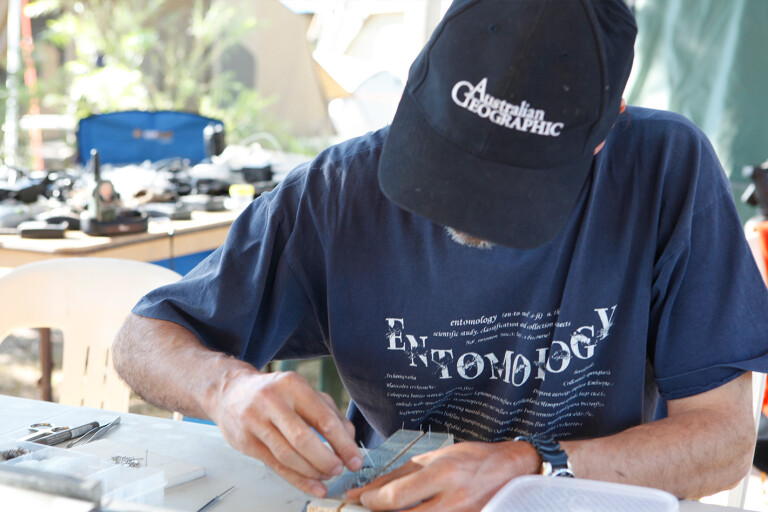
This was going to be no ordinary stay in the Kimberley. In the next two weeks, I would find myself inspecting goanna traps, hiking and wading through gorges in the dark, netting butterflies, assisting in micro-chipping frogs and snorkelling for turtles.
Travelling with biologists and ecologists opened up a world of hidden life that could otherwise be easily overlooked – and is at risk of being lost altogether.
THE FRONT LINE
Prior to the scientific expedition, volunteers for not-for-profit foundation, Stop the Toad, endured weeks of labour in the early dry season heat to construct a 1.3km toad-proof fence at the boundary of Emma Gorge, just outside El Questro, in an attempt to create a refuge for native fauna from the toxic toad.
As part of the AGS research, pit and funnel traps were laid along the toad fence to catch and document animals moving around the area. On a daily basis, herpetologists and volunteers would uncover dozens of frogs, reptiles and tiny marsupials for study.
Dubbed “the fence that keeps on giving”, the numbers of species found were high, yet a sense of melancholy lingered like bulldust in the air as the scientists predicted the findings of follow-up studies just one or two wet seasons down the track.
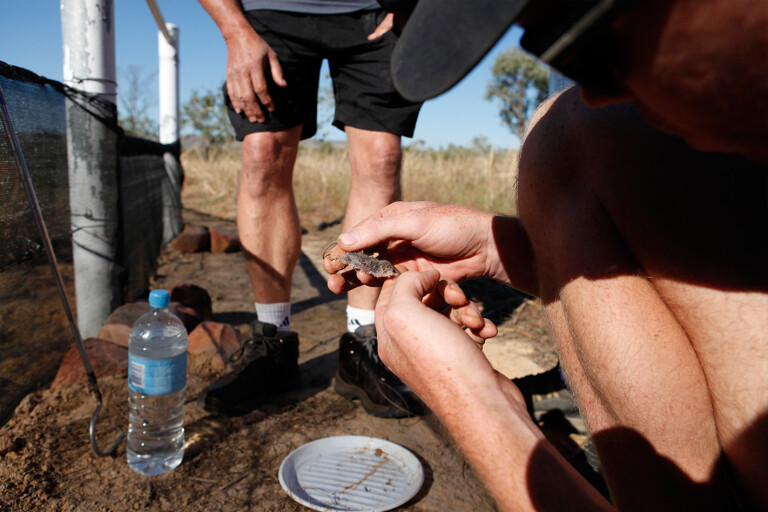
“The fence is effective in sampling small fauna, but as far as stopping the toad goes, I think, sadly, all it’s doing is buying time,” said Steve Wilson, who was using the expedition to document species for the next edition of his award-winning, co-authored book, A complete guide to the reptiles of Australia.
“For example, those ancient yellow-spotted monitors that patrol the campground will probably be dead in two years. Almost all because of toads.” But the undercurrent of despondency didn’t affect the sense of responsibility surrounding the trip.
As expedition chief scientist, Sean Doody, pointed out, community efforts have significantly impacted toad numbers and measurably reduced their damage over the years, while studies like the AGS expedition have a real chance of contributing to future attempts at controlling the toad.

Sean spent most days on the Ord River, near Kununurra, where the cane toad has already arrived, in order to produce quicker results and secure support for more cane toad impact studies down the track.
“If we don’t understand the damage the toads cause, there’s no way we can say we’re doing anything about it,” Sean said.
FISHY BUSINESS
The tinny rattled on the roof of the old Troopie as we bounced over boulders towards the creek’s edge. I was spending the day with fish ecologists Brendan ‘Ebb’ Ebner and David ‘Morgs’ Morgan, who collaborated on the trip, documenting freshwater species around El Questro.
For biologists that specialise in water-based animals, their sense of humour couldn’t get much drier, and there was plenty of material as the volunteers stuffed bespoke contraptions for attracting and filming fish with sun-ripened pilchards and prawns. (Ebb: “I don’t know much about buying perfume for my wife, but I know she doesn’t much appreciate Chanel Negative 147.”) The devices are called Baited Remote Underwater Video Stations – or BRUVS – making the scientific duo, and anyone involved in the research, officially BRUVers.
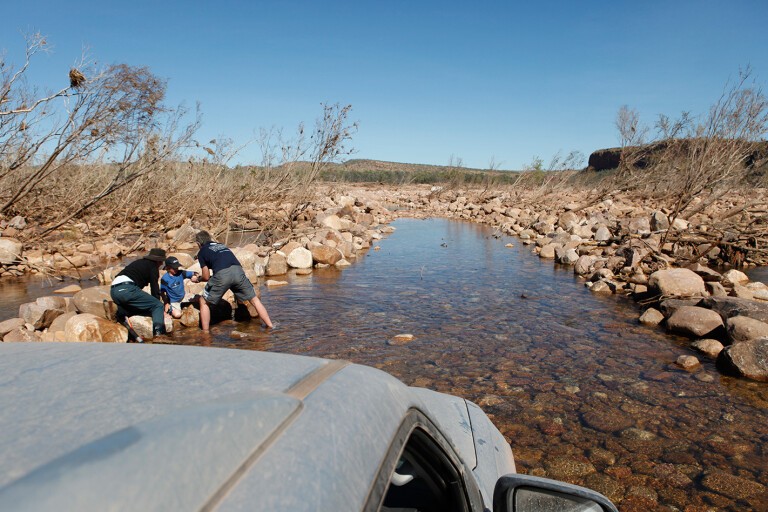
Morgs drove up from Perth, while Ebb was over from Far North Queensland. The two had collaborated on several studies prior to the expedition and could have been mistaken for a couple of typical fisherman – with the added insight of doctorates in ichthyology. And, as with most fishos, there was always time for a yarn and a laugh with these two, but fish conservation was something they took very seriously.
Cane toads are poisonous at every stage of their existence; as an egg, tadpole and, of course, a fully-developed toad. This means that land animals with a taste for amphibians are not the only creatures at risk as toads migrate across the country.
“Sean Doody recommended that we fish-heads come along on the AGS trip, as he has found freshwater crocodiles in the Northern Territory dead following consumption of cane toads,” explained Ebb. “Since freshwater crocodiles are a major predator of fish, we suspect the cane toad invasion may have repercussions for the freshwater fish community in the Kimberley.”
But the risks could be even further reaching. Morgs spends a lot of time working with indigenous Australians and fears for those who traditionally cook fish whole as they could unintentionally ingest toad poison, resulting in illness, or even death. They may be larrikins, but Ebb and Morgs know more than most that the potential damage caused by the toad is no joke.
CLOSELY MONITORED
I couldn’t help but cringe at the grating sound of metal on rock as the Pajero dropped wheels between boulders along Branco’s Crossing. The driver, scientist Colin McHenry, was busy scanning the rocks for any signs of life, while I mentally prepared my explanation to Mitsubishi about the Paj’s bruised and battered belly.
Suddenly, there was a shout of excitement from Colin’s son, Cormac, sitting next to me in the back seat. I quickly became the only person left in the vehicle as Colin braked, and he and an excited volunteer followed Cormac through the shin-deep water to a small Mitchell’s water monitor (Varanus mitchelli) that had been sunning itself by the crossing. The monitor (or goanna) would be bagged and taken back to camp for study (and later returned to the same spot), for the good – unbeknown to him – of his species.
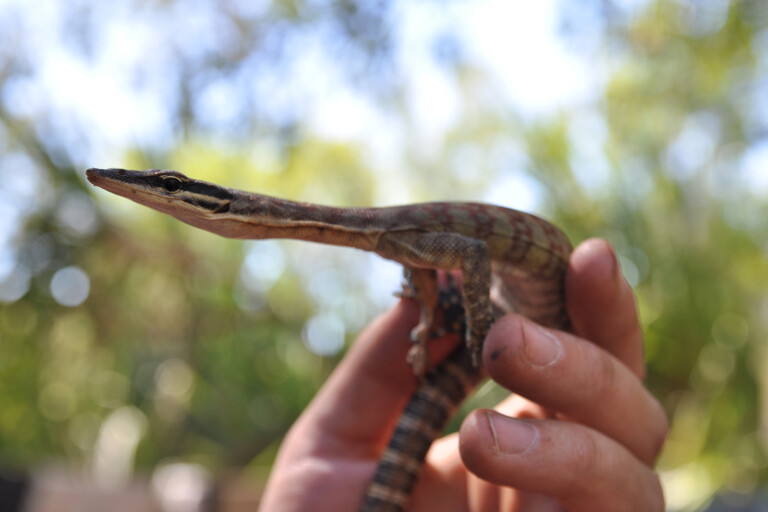
For Colin, a biologist who has specialised in palaeontology and is currently focussing on the biomechanics of goannas, the AGS expedition was a chance to continue his ongoing studies in and around El Questro.
As well as capturing, measuring and recording the goannas found in the park, Colin and his team were using 3D photography to produce computer models of reptiles. The scientists would nab an available 4X4 early in the morning – before the heat of the day set in – to check traps laid around the park, with catches taken back to camp to be photographed from multiple directions to produce the models.
Doing so would help the scientific community gain a comprehensive understanding of goanna populations in the Kimberley before the arrival of the toad, which will no doubt provide a dangerously irresistible morsel for the impressive lizards.
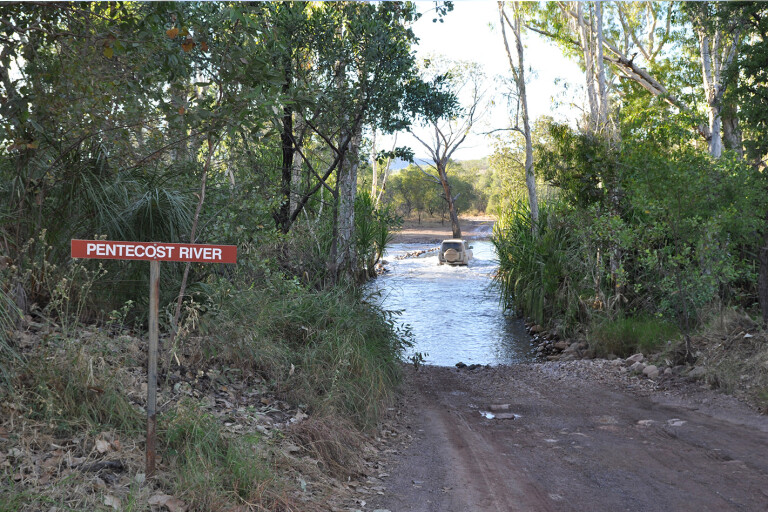
The Pajero handled the crossing with no problem, and the scientists had one more specimen to fill out their data. Soggy shoes returned to the Paj’s leather interior and we continued to clank and clunk on our way, all smiles and straight priorities.
MOBILE HOMERS
One of the reasons Christina Castellano, US-based director of turtle conservation at the Orianne Society, is so passionate about turtles is that “they make people happy”, she said. And it’s true.
As we waded through a creek just outside Emma Gorge (about two kays off the Gibb River Road) and I spotted my first sandstone long-necked turtle (Chelodina burrungandjii), I couldn’t help but smile at the creature I held up proudly, announcing my discovery to Christina and her husband Sean Doody, searching the reeds ahead.
Christina quickly measured, weighed, documented and harmlessly notched the turtle before returning it to the water, as she did the eight others we found that day – along with dozens more documented over the duration of the expedition.
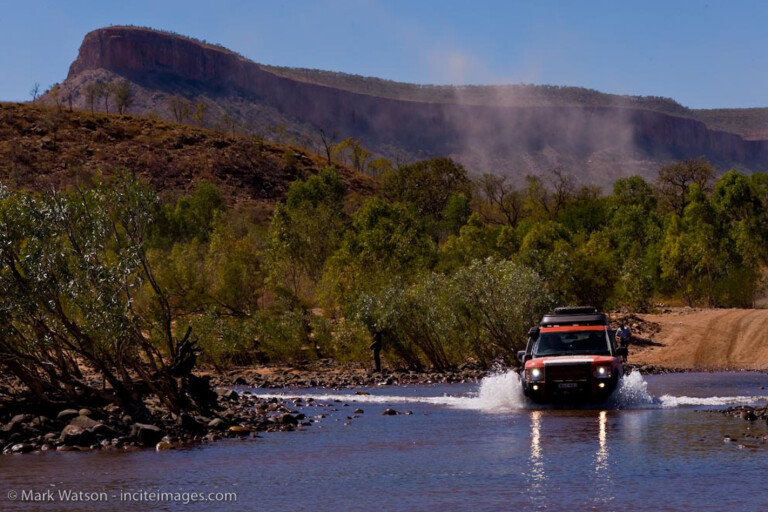
Sadly, turtles will be living side-by-side with the cane toad when it arrives in the Kimberley, which may prove a perilously close liaison, given turtles’ taste for small, meaty prey. “The sandstone long-necked turtle is an efficient ambush predator,” explained Christina.
“It hides under a rock or among tree roots beneath the water, waiting for the movement of passing prey, then strikes quickly, inhaling fish, insects, and soon, perhaps, cane toads. We know that some species, like goannas, can die from just mouthing the toxin, so even if the turtle spits out the toad, it may still prove to be fatal.”
Christina’s data collected in the Kimberley will not only help to measure any declines after the arrival of the toad, it will also help garner a better understanding of these “secretive” creatures, of which – like almost everything in this remote part of the world – surprisingly little is known.
A DAY IN THE LIFE
I joined a group of volunteers following Simon Cherriman up a steep ascent to see an eagle’s nest he spotted in a big boab tree.
Perched on a rock, breathless from the hike, and absorbing the view over El Questro, I reflected on the fact that, just that morning, I had been netting butterflies near the idyllic Zebedee Springs with entomologist Michael Braby. Author of definitive field guide, Butterflies of Australia, Michael used the expedition to study butterfly species in El Questro for the Northern Territory Government.
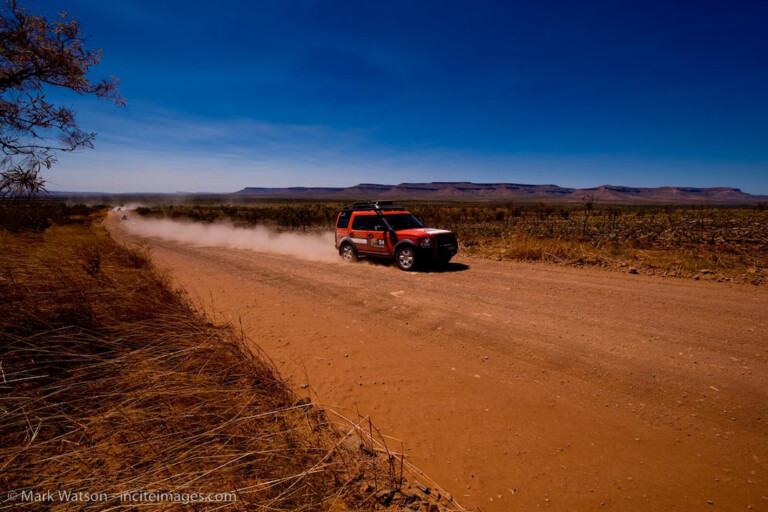
During the trip, he documented a total of 50 different species – an impressive number, considering there are 85 known species in the entire Kimberley. While the probable impact of cane toads on invertebrates such as butterflies is less tangible, introduced species affect entire ecosystems, and indirect impacts are also important to measure.
Meanwhile, Simon Cherriman’s object of study – and his unrivalled passion – the wedge-tailed eagle (Aquila audax) is at a more direct risk from the spread of the cane toad through predation – of the toad itself, or, more likely, the carrion of animals that have died ingesting the toad.
Two metre tall, dreadlocked, full of enthusiasm and winner of the 2011 AGS Young Conservationist of the Year award, Simon used the trip to collect material for his second documentary, and simply to gain a greater understanding, like everyone else, of what’s actually out there.

Ankles stinging from the spinifex grass, we eventually left the eagle’s nest and descended the hill towards the setting sun, ready to finish another long day in the field.
Well, not quite yet. Simon was to make one side trip before returning to camp, to set a motion-sensing camera and hopefully pick up wallaby footage. The group followed his lofty figure across the hill, when he pointed excitedly ahead. He had spotted a fresh snake slide – the herpetologists would love this. Eyes to the ground, we continued to trail him, and the elusive reptile, into the scrub.
Hopefully the camp cook wouldn’t mind if we were a little late for dinner.
THE IMPORTANT STUFF
In order to get anywhere around El Questro Wilderness Park, a capable 4X4 is a must. Sand, corrugations and rocky water crossings are the name of the game out here (not to mention access via the infamous Gibb River Road, and the dirt tracks around the spectacular Cockburn Ranges) and the El Questro park rangers are well accustomed to recovering travellers with vehicles (and experience) not quite up to scratch.
So, while the scientists were busy documenting mammal and reptile species, it was very important that – as the resident 4X4 journo – I also conducted a thorough investigation into the awesome off-road tracks on offer. Oh well, if I must…
SaddleBack Ridge
After trundling down a steep embankment of boulders to cross the Pentecost River, the rocky terrain quickly turns to soft bulldust surrounded by dry spinifex landscape as you climb the narrow, winding 7km track to the Saddleback Ridge lookout – a popular sunset viewing spot. It’s a good idea to engage low-range for the majority of this track, particularly at the water crossing and on descent. Tyres should be kept below road pressures for driving throughout El Questro.
Branco’s Lookout
The write-up for the track to Branco’s back at the El Questro station didn’t sound as serious as the one for Saddleback, but it was more of a challenge, if you ask me. Branco’s Crossing, which traverses the Chamberlain River, was a real test for the vehicles’ underbody protection. Engage low-range, take it slow, and try not to cringe as you clank and clunk across the slippery rocks. Another steep, twisting and turning climb and plenty of soft bulldust makes up the rest of the track, with a spectacular lookout over the Chamberlain as fitting reward.
Explosion Gorge
While this track was officially still closed when I visited El Questro, following last year’s record wet season, I was lucky enough to tag along with wilderness park manager, Micko Bass, on a staff reconnaissance trip in one of the station safari vehicles (a modified LandCruiser ute). This track turns off after Branco’s Crossing and ends at Explosion Gorge where Micko told me a big salty resides. This would make a great combined off-road jaunt, finishing with the nearby track to Branco’s Lookout for yet another outback sunset opportunity.
KNOW THINE ENEMY
The cane toad (Bufo marinus) was introduced from Hawaii to north Queensland in 1935 in an attempt to control sugar cane beetles. The secretions of its prominent parotoid glands are highly toxic and dangerous to almost all native carnivores.
Cane toads are toxic at every stage of their existence. The female lays eggs in the tens of thousands, and these form dense schools of tadpoles.
Distribution extends from northern New South Wales, throughout Queensland and the Northern Territory, to the eastern border of Western Australia, into the Kimberley.
While community, government and scientific efforts have culled huge numbers over the years, there have been no sure signs of success in halting the cane toad’s spread.

COMMENTS